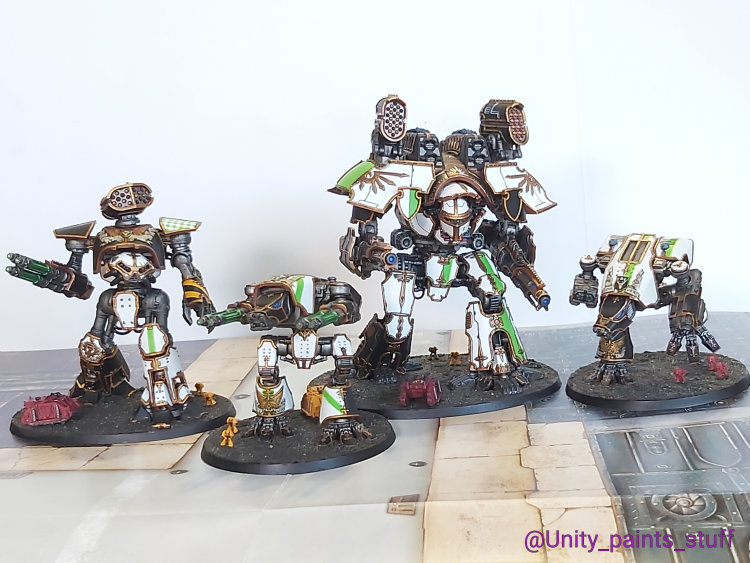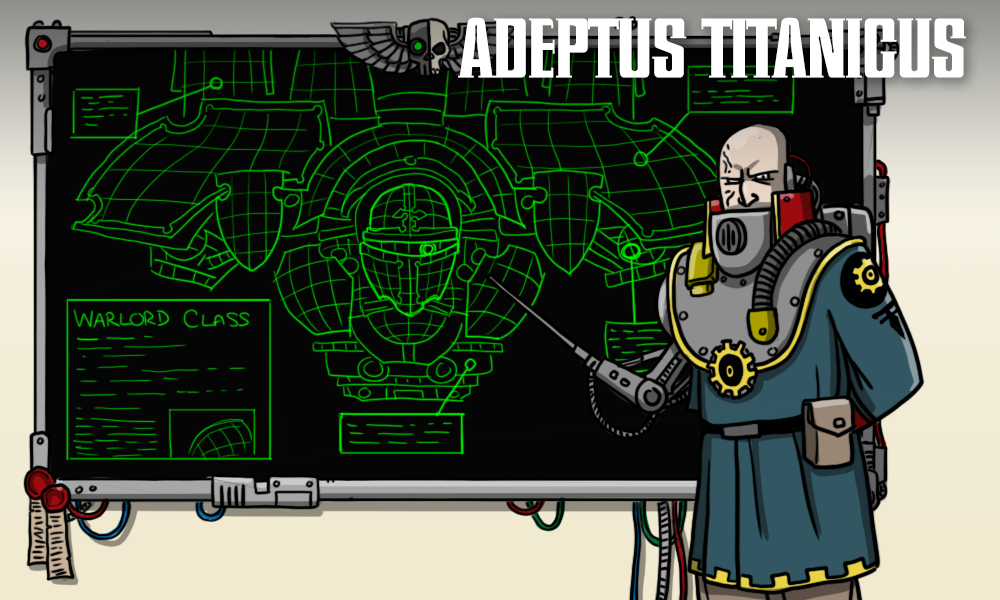Welcome back to Goonhammer’s series for aspiring Titan Principes. We here at Goonhammer’s own Collegia Titanica know that Adeptus Titanicus can seem intimidating to players unfamiliar with its particular quirks, but this series aims to equip you with everything you’ll need to play out epic clashes on the battlefields of the far future with your very own Titan Battlegroup.
Adeptus Titanicus is a game with surprising depth, but that depth can make getting into the game a daunting prospect for newer players. While there are plenty of different ways to get into this game, the number of options for building your first list can be overwhelming. To that end, we’ve broken down a few different categories and offered some suggestions to get you moving in the direction you want to go.

Simplicity
Despite the low model count, every decision in Adeptus Titanicus comes with weight. If you are new to the system, prone to analysis paralysis, or simply want to chill out a bit while playing, consider some of the below options to reduce the number of variables to worry about.
Soggy: I feel seen with my excessive use of Legio Ignatum Ferrox maniples, but that’s entirely ok.
Legions to Consider
On the Loyalist side, Legio Astorum has rules that are both straightforward and powerful. The re-rolls in the damage control phase helps all of your Titans out, and extra movement the first two rounds are easy to keep track of (just need to remember to roll twice when pushing the reactor when doing so for the rest of the round).

For Traitors on the other hand, one of the simplest Legios to play is Legio Tempestus. Their main trick is the ability to shoot back when a Titan would be destroyed so long as it passes a Command check. This allows you to play a bit more aggressively with the knowledge that, even if you get caught out, your opponent isn’t likely to be able to avoid retribution.
Maniples to Consider
The first choice here is also the most obvious: the venerable Axiom Battleline Maniple. Not only is the benefit it gives you simple to understand, it also removes a decision point, which will free you up to spend more time thinking about where you’re going to move. It also lets you structure the sequence in which you issue orders in a more reactive or dynamic way, should the situation call for it.
Other maniples worth considering are the Ferrox Light Maniple, which gives you benefits for getting in close, the Perpetua Battleline Maniple, which makes it easier to keep your Titans in peak fighting condition, and the Venator Light Maniple, which can get off a few extra shots in the course of just playing your game the way you were already going to.
Legions to Avoid
Any Legio with an activation or squadroning gimmick is a potential trap for the unwary – Legio Vulcanum and Legio Venator in particular can be difficult to get mileage out of while you’re still learning the base game. Lowering your activation count can be a huge disadvantage if you’re not prepared to play around it, and the Iron Spiders in particular will see a benefit from an experienced player when deciding which Titans to put into a squadron for the turn, or whether you’re even going to do it at all.

Maniples to Avoid
You may want to steer clear of the Corsair Battleline Maniple and the Lupercal Light Maniple for your first few games: while both boast extremely powerful effects, they also presume that you’ve got a pretty good handle on how to play the game. After all, movement in Titanicus is one of the more involved parts of the game, and getting a feel for how to really abuse these maniple traits is going to take you a few games.
The Extergimus Heavy Maniple is also a tougher one to use, but it’s more down to the fact that Warlords have poor movement stats and are usually running at about the limit of what their reactors can handle anyway.
Soggy: Don’t forget to pack Tracking Gyros on all of your Engines in an Extergimus as you will often find yourself outnumbered and possibly outmanoeuvred.
Range of Engagement
Maybe what drives you isn’t so much ease of play, but wanting to bring a particular type of weapon to bear? Whether you want to call down the thunder from across the table, dominate the mid-board in mid-ranged firefights, or go in for the kill with melee weapons, the tools are there for you to build the list of your dreams.
Gunline Legios
Sometimes all you want to do is line up and fire the biggest gun you got as far down-range as possible. If this describes you, then look no further. Legio Defensor are the undisputed kings of the round 1 alpha strike, especially now that they have access to some more effective heat management via stratagems and wargear. Legio Praesagius are famed for their precision gunnery via the Pinpoint Accuracy trait and Precision Volley stratagems, allowing them to focus down targets before they get close.

Mid-Range Legios
The majority of games of Adeptus Titanicus are won in the midfield – gunlines will often only have a turn or two before the melee Titans close in, and sometimes before those melee Titans can get there the battle has already been lost. The chaos of the midfield requires the ability to flex to either role.
For Loyalists, Legio Ignatum are a solid example of this with a variety of tools in their belt to work at different ranges. The rerolls from We Loyal Few at short range will motivate you to close into your target, while making melee threats think twice with the ability to overwatch from Punish Their Folly.
On the traitor side and also a poster-child, Legio Fureans have a great combination of traits and tools that find their sweet spot in the middle of the battlefield. Hunting Auspex makes shots over 12” easier to land – including called shots – making it one of the best Wargear Options in the game. They also have powerful princeps traits like Titan Stalker or Humadru Savage for bringing down their quarry in close quarters. On top of all this, they have Offensive Surge which can turn tables in a single combat phase, as long as you play it at the right time.

Close-Quarters Legios
Legio Vulpa are the undisputed masters of close-combat in Titanicus, bringing not only improved accuracy with all weapons in close, but also some monstrously powerful attacks with their Disruption Emitters wargear. You’ll be hard-pressed to find a better home for a list built around the Arioch Titan Power Claw. Alternatively, Legio Laniaskara combine guaranteed charges with a frankly ridiculous volume of attacks to turn Reavers with chainfists into absolute terrors.
On the loyalist side, Legio Gryphonicus are your go-to. While it might seem at first glance like their rules could apply to any range, in practice it’s a lot easier to get mileage out of their Lust for Glory trait in melee as you don’t have to worry about stripping voids before you shove a chainfist up their exhaust pipe.
Other legions you might look into if you want to get up close and personal with your prey include Legio Honorum or Legio Magna.
Titan Class
If the reason you’re here is for a particular type of Titan, rest assured that there’s a Legio for you.
Warlords
If you want to take more Warlords (and who doesn’t!) look no further than Legio Tritonis. They can replace any mandatory Reavers with Warlords, and get to improve their apocalypse missile launchers to boot. For another take on these huge war machines, look at Legio Metalica, who can double-activate with these huge engines once per round, and use their Harmony and Order stratagem to make sure their machine spirits don’t take control at the wrong time.

Legio Honorum and Legio Crucius are solid choices for Loyalists, while Legio Vulcanum or Legio Krytos like bringing larger engines as well.
The Extergimus and Regia maniples are your go-to choices if you want multiple Warlords, though you can get mileage out of the Fortis maniple as well.
Reavers
The obvious choice for the discerning Reaver enthusiast is Legio Gryphonicus, who can swap in Reavers for any Warlord or Warhound in their maniple. Add in their Reaver-specific wargear and the Lust for Glory trait and these Titans can really sing. Legio Venator can also swap in Reavers for mandatory Warlords, and their squadroning gimmick lets them punch well above their weight.
For Traitors, consider Legio Kulisaetai. They may not be able to swap in Reavers for other engines, but most of their rules work well with a Reaver’s game plan. They can extend short range to get more mileage out of melta cannons, gatling blasters, and laser blasters; use Accelerated Autoloaders to make their Reavers’ apocs fire like Warlords; and make a pre-game move with all their Reavers to top it off.
The obvious maniple choice here is the Corsair, which can only take Reavers. But the nice thing about playing Reavers is that you can build them to fill just about any battlefield role, so they’re useful in any maniple you can shove them in.
Warhounds
Many Legios can make great use of the trusty Warhound chassis, however there is a prime example for both sides, which also have their own deployment shenanigans. For Traitors, the fan-favourites of Legio Audax can *only* take Warhounds in exchange for their own unique Canis maniple. Loyalist Legio Solaria have multiple wargear options and traits which focus on Warhounds but aren’t restricted to only taking them, giving them some more options.
Similar to the Corsair, the Warhound exclusive Lupercal is the obvious choice with it’s powerful activation powers. Otherwise, Warhounds excel in both Ferrox and Venator Maniples and are otherwise great support options for heavier battlegroups.
Flexibility
Of course, maybe you don’t want a force that leans in one direction or another. Thankfully, there are plenty of options if you want to keep your opponent guessing as to what you will take to your next game.
Flexible Legios
For Loyalists, Legio Oberon can be built to nearly any game plan with some powerful tricks up their sleeve. Performing the multiples of the same action in one turn is incredibly easy for them thanks to Efficient Planners and Decisive Action – this can complement different play styles such as melee-heavy for combo charges or for gunlines going on Split-Fire/First-Fire or Emergency Repair when you need to hang on at the 11th hour of your games. The ability to get additional stratagem points is neat and helps you take their main party trick, Strategiser – Titanicus’s version of the 8th Edition 40k stratagem Agents of Vect. Being able to cancel a key stratagem which would otherwise win the game is incredibly powerful, let alone just the threat and mindgames of having it at your disposal.

The Gore Crows of Xana II have some of the coolest toys thanks in no small part to their somewhat questionable history. Their Storm Frag Shell upgrade turns the best anti-void weapons in the game into viable anti-amour weapons as well, working well on Warhounds through to Warlords. Thanks to Cull the Weak and Scent of Blood, they also have the ability to fire out of sequence which will keep your foe on their toes.
Don’t see your favorite Legio?
Don’t worry. Just because we haven’t pointed them out here doesn’t mean you shouldn’t play them. Any Legio can try any strategy, though some are obviously better at certain gameplans than others. At the end of the day, whether you’re choosing your list for simplicity, gameplay, a favorite Titan class, or just because you think the paint scheme is rad, as long as you’re happy with it you’ve made the right choice.
Soggy: Everyone’s a winner when you’re playing Titanicus.
Games of Adeptus Titanicus are like Onions…
…they have many layers and that depth will keep the game interesting for a long time to come. And while this is by no means an exhaustive list of how to approach each of the above categories – there are just too many options to be covered here – the suggestions here should be helpful as you’re trying to work out what Legios and maniples to consider building towards.

One final note: don’t feel like you have to be locked into your initial choice. Play a few practice games, get a feel for what you like, and collect the Battlegroup that works for you. The suggestions in this article are a solid jumping-off point for your first (or next!) list, but they’re by no means the only way to approach things.
In conclusion: Play Titanicus.


